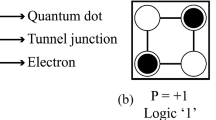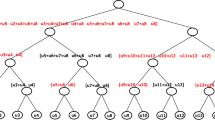Abstract
By increasing the length of input operands, standard binary number representation cannot satisfy the need for area-time-power efficient systems due to carry propagation chain problem. Redundant residue number system (RRNS) would be an appropriate solution to this demand as it divides large numbers to smaller ones on which the arithmetic operations could be performed in parallel. Maximally redundant signed-digit RNS (MRSD-RNS) has been recently presented as a low-power RRNS because the addition unit based on this number system consumes the least power among the existing RRNS encodings. In this work, a low-power MRSD-RNS multiplier for modulo 2n− 1 is proposed for the first time. The implementation results based on the TSMC-90 nm CMOS Technology indicate that our proposed design outperforms power, area, power-delay-product and area-delay-product in comparison with the efficient existing RRNS multipliers for the cases in which delay is not a limiting factor. It has also the least delay among the existing high-radix RRNS multipliers. Therefore, the proposed multiplier can meet the strict area-time-energy constraints which can be used as the core of signal processor in many applications.






















Similar content being viewed by others
References
A. Armand, S. Timarchi, Low power design of binary signed digit residue number system adder, in 24th Iranian Conference on Electrical Engineering (ICEE) (2016), pp. 844–848
A. Avizienis, Signed-digit number representations for fast parallel arithmetic. IRE Trans. Electron. Comput. 10, 389–400 (1961)
H. Garner, The residue number system. IRE Trans. Electron. Comput. EC-8, 140–147 (1959)
G. Jaberipur, B. Parhami, M. Ghodsi, Weighted two-valued digit-set encodings: unifying efficient hardware representation schemes for redundant number systems I. IEEE Trans. Circuits Syst. 52, 28 (2005)
M. Khan, S. Din, S. Jabbar, M. Gohar, H. Ghayvat, S.C. Mukhopadhyay, Context-aware low power intelligent SmartHome based on the Internet of things. Comput. Electr. Eng. 52, 208–222 (2016)
I. Koren, Computer Arithmetic Algorithms (Universities Press, New York, 2002)
X. Liu, E.S. Sinencio, An 86% efficiency 12 µW self-sustaining PV energy harvesting system with hysteresis regulation and time-domain MPPT for IOT smart nodes. IEEE J. Solid-State Circuits 50(6), 1424–1437 (2015)
A.S. Madhukumar, F. Chin, Enhanced architecture for residue number system-based CDMA for high-rate data transmission. IEEE Trans. Wirel. Commun. 3, 1363–1368 (2004)
H. Marzouqi, M. Al-Qutayri, K. Salah, Review of Elliptic Curve Cryptography processor designs. Microprocess. Microsyst. 39(2), 97–112 (2015)
M.C. Mekhallalati, M.K. Ibrahim, New high radix maximally-redundant signed digit adder, in IEEE International Symposium on Circuits and Systems, vol. 1 (1999), pp. 459–462
K. Navi, A.S. Molahosseini, M. Esmaeildoust, How to teach residue number system to computer scientists and engineers. IEEE Trans. Educ. 54, 156–163 (2011)
B. Parhami, Generalized signed-digit number systems: a unifying framework for redundant number representations. IEEE Trans. Comput. 39(1), 89–98 (1990)
B. Parhami, Computer Arithmetic: Algorithms and Hardware Designs (Oxford University Press, Inc., Oxford, 2009)
D.S. Phatak, I. Koren, Hybrid signed-digit number systems: a unified framework for redundant number representations with bounded carry propagation chains. IEEE Trans. Comput. 43, 880–891 (1994)
D.S. Phatak, T. Goff, I. Koren, Constant-time addition and simultaneous format conversion based on redundant binary representations. IEEE Trans. Comput. 50, 1267–1278 (2001)
A. Safari, C.V. Niras, Y. Kong, Power-performance enhancement of two-dimensional RNS-based DWT image processor using static voltage scaling. VLSI J. Integr. 53, 145–156 (2016)
M. Salim, A.O. Akkirman, M. Hidayetoglu, L. Gurel, Comparative benchmarking: matrix multiplication on a multicore coprocessor and a GPU, in Computational Electromagnetics International Workshop (CEM) (IEEE, 2015)
M. Saremi, S. Timarchi, Efficient modular binary signed-digit multiplier for the moduli set {2n − 1, 2n, 2n + 1}. CSI J. Comput. Sci. Eng. 9(2 & 4(b)), 52–62 (2011)
M. Saremi, S. Timarchi, Efficient 1-out-of-3 binary signed-digit multiplier for the moduli set {2n − 1, 2n, 2n + 1}, in 2013 17th CSI International Symposium on Computer Architecture and Digital Systems (CADS) (IEEE, 2013)
S. Timarchi, K. Navi, Efficient class of redundant residue number system, in Proc. IEEE Int. Symp. WISP (2007), pp. 475–480
S. Timarchi, K. Navi, Arithmetic circuits of redundant SUT-RNS. IEEE Trans. Instrum. Meas. 58(9), 2959–2968 (2009)
S. Timarchi, M. Fazlali, Generalised fault-tolerant stored-unibit transfer residue number system multiplier for moduli set {2n − 1, 2n, 2n + 1}. IET Comput. Digit. Tech. 6(5), 269–276 (2012)
S. Timarchi, P. Ghayour, A. Shahbahrami, A novel high-speed low-power binary signed-digit adder, in 16th CSI International symposium on Computer Architecture and Digital Systems (CADS) (2012), pp. 357–363
S. Timarchi, M. Saremi, M. Fazlali, G. Georgi, High-speed binary signed-digit RNS adder with posibit and negabit encoding, in 2013 IFIP/IEEE 21st International Conference on Very Large Scale Integration (VLSI-SoC) (IEEE, 2013), pp. 58–59
S. Timarchi, N. Akbarzadeh, A. Hamidi, Maximally redundant high-radix signed-digit residue number system, in 18th CSI International Symposium on Computer Architecture and Digital Systems (CADS) (2015)
E. Vassalos, D. Bakalis, Combined SD-RNS constant multiplication, in 2009 12th Euromicro Conference on Digital System Design, Architectures, Methods and Tools (2009), pp. 172–179
V. Volkov, J.W. Demmel, Benchmarking GPUs to tune dense linear algebra, in International Conference for High Performance Computing, Networking, Storage and Analysis, 2008. SC 2008 (IEEE, 2008)
Z. Wang, Y. Liu, Y. Sun, Y. Li, D. Zhang, H. Yang, An energy-efficient heterogeneous dual-core processor for Internet of Things, in IEEE International Symposium on Circuits and Systems (ISCAS) (2015), pp. 2301–2304
Sh. Wei, K. Shimizu, Residue arithmetic circuits using a signed-digit number representation, in IEEE International Symposium on Circuits and Systems
Sh. Wei, J. Changjun, Residue signed-digit arithmetic and the conversions between residue and binary numbers for a Four-Moduli Set, in 2012 11th International Symposium on Distributed Computing and Applications to Business, Engineering & Science (DCABES) (IEEE, 2012)
M. Zhang, Sh. Wei, High-speed modular multipliers based on a new binary signed-digit adder tree structure, in Ninth International Symposium on Distributed Computing and Applications to Business, Engineering and Science (2010), pp. 615–619
Author information
Authors and Affiliations
Corresponding author
Rights and permissions
About this article
Cite this article
Timarchi, S., Akbarzadeh, N. Area-Time-Power Efficient Maximally Redundant Signed-Digit Modulo 2n − 1 Adder and Multiplier. Circuits Syst Signal Process 38, 2138–2164 (2019). https://doi.org/10.1007/s00034-018-0957-7
Received:
Revised:
Accepted:
Published:
Issue Date:
DOI: https://doi.org/10.1007/s00034-018-0957-7




